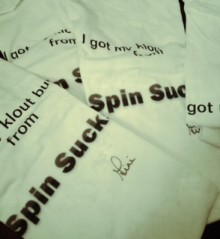It started on my last birthday.
I’d received all sorts of friendly greetings and good wishes on Facebook – thank you for that! – and I spent time chatting back. Then a day or so later, for no apparent reason, I noticed my Klout score had gone up. Weird was my initial thought. Who cares was my second.
It didn’t take long to figure out what happened. All the activity helped me get a Klout birthday bump.
Which has nothing to do with influence.
Sure enough, the score went down as quickly as it rose. I didn’t think about it much more till I wrote a post last summer for Spin Sucks on the future of public relations. And because it was relevant (and the Spin Sucks community is a bit crazy), there was some good interaction and…
My Klout score went up again.
I got another bump.
That led to an idea. I wanted to see if my next post could push my score higher artificially. My goal was 70, a full five point increase. And to make even more tempting, I offered a few silly prizes.
An A student?
Klout scores have always reminded me of high school grades. So a 90 would be equivalent to an A+*, 80 a A, 70 a low-B, and so on.
Essentially I was trying to go from being a C to a B student. And I wanted to do this by enlisting the cheerleading squad, and not via hard work. In any environment, that’s a dubious path.
But it was all for scientific research, right?
The results came in and – cue sad trombone – I did reach 70, fleetingly. Now it goes up and down like the portfolio of a day trader.
The question is: what did I learn?
I’d always suspected an intense level of activity within a tight community over a short period of time would artificially inflate a Klout score. And that seems to hold true.
But what does that say about influence scoring and true influence? In the case of Klout, they seem to measure it over relatively brief time spans, whereas in real life influence is built up slowly over time and usually sustained – unless you’re the Mayor of Toronto…
And while it’s fun to see the line on the graph edge up, did I get any new clients or other opportunities from the bump? Nope. So from a purely business perspective, this tells me it’s likely not a metric I should give much credence to.
Influence is not a call to action
My big takeaway centers more on the concept of influence, and the way we promise it to brands. It feels like we’re positioning it all wrong. Influencers are not people who utter a command and their automatons blindly follow (at least, let’s hope not).
True influence has to do with deep, trusting relationships, as well as persuasive communication encouraging people to consider another point of view.
Influence is far more complex than a simple call to action, which seems to be what we’re offering. So let’s stop looking at it like that.
I’m curious to hear how you’d define influence and how you use it in your content marketing programs.
And now this faux-scientist bids you farewell as my Klout roll of the dice comes to an end. Till the next experiment…
*Canadian equivalent grades. And thanks to Paula Kiger and Rebecca Amy Todd for helping out! A version of this post originally appeared on Spin Sucks.


Digital_DRK Thanks Darryl. I laughed when you referenced your inner Sally Field. Good point about return on influence – as well as the context that shows where a person is influential. I’ll be interested to hear what happens in the days after your Klout bump.
And happy birthday!
As one who just celebrated a birthday, I awoke the next morning very curious to see how Klout had converted that scurry of congratulatory activity within my social streams.
Because of the kindness of a very influential person, I had actually garnished more birthday popularity than I could have imagined, edging my score up almost 3 points over night.
However I think a significant change within a short period of time of ones Klout score, is a popularity bump as opposed to a measurement of any real long term influence they may have. As Danny Brown and Sam Fiorella warn, that score should be considered within a context of ROI (Return On Influence).
I will say, Klout does connect with my inner Sally Field “…You like me…you really like me”
I’m sure somewhere during my Monday morning commute to work, I’ll glance at my Klout and sigh as that Cinderella bump fades.